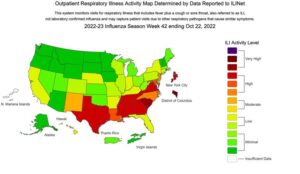OCTOBER 28, 2022

Flu-related hospitalizations nationwide have risen dramatically in recent weeks, reaching levels historically not seen until much later in flu season, according to data released by the Centers for Disease Control and Prevention Friday.
“We haven’t seen this level of activity this early before,” said Lynnette Brammer, team lead of the domestic influenza surveillance team at the CDC. Typical flu seasons usually don’t pick up steam until December.
Flu hospitalizations are rising across all age groups, especially children. The increase comes as other respiratory viruses, including RSV, or respiratory syncytial virus, are also spiking in kids. According to the Department of Health and Human Services, 76% of pediatric hospital beds nationwide are full.
“We realize the potential implications of the co-circulating viruses all at once,” Brammer said. “We’re taking it very seriously.”
Also Friday, the CDC reported the first flu-related death in a child so far this season. The CDC did not provide any details about the child, however KVEO, the NBC affiliate in Brownsville, Texas recently reported that a 3-year-old girl died after testing positive for the flu.
While the flu and similar viral illnesses are rising nationwide, they’re notably high across the Southeast and Eastern Seaboard — from Texas to Georgia, and South Carolina up to Virginia and New Jersey, according to the new report.
Doctors are not required to report each positive flu test to public health officials, so the CDC and others monitor likely flu activity by looking at “influenza-like illnesses”: a fever of at least 100 degrees Fahrenheit and a cough and/or sore throat without any other known cause.
Doctors also warn that other infections can follow severe cases of the flu, including bacterial infections like pneumococcal pneumonia. Dr. Greg Poland, director of the Mayo Clinic’s Vaccine Research Group in Rochester, Minnesota, worries that this season could be bad for these post-viral infections.
Dr. Shannon Martinello, a pediatrician in private practice in New Haven, Connecticut, is already seeing an uptick in post-viral bacterial illness. “The more mucus they have, and the more congested they are, it increases their risk of ear infections,” she said.
“I always tell parents when their kids have flu, it’s gonna be a rough week, and they’re gonna get better,” Martinello said. But if a child who has recovered from the flu starts to feel sick again a week or 10 days later, she advises parents to take the child back to the doctor. “I want to re-listen to his lungs and re-check his ears and make sure that something else hasn’t happened as a secondary issue.”
There are early signs that this year’s flu shot appears to work well at keeping people out of the hospital. A report on Chile’s flu season, released Thursday by the CDC, found the vaccine was 49% protective against flu-related hospitalizations.
That might seem low, but from 2015 to 2020, flu shot effectiveness in the U.S. ranged from 29% to 48%.
It’s unclear whether this year’s flu shots in the U.S. will be as effective as was found during Chile’s flu season. But the shots used in both countries have one of the same targets: the H3N2 flu strain, which accounts for a majority of flu cases currently detected in the U.S.
H3N2 is an influenza A virus and is often associated with increased hospitalizations. Kids under age 5 may be at particular risk.
The CDC recommends that everyone 6 months and older get an annual flu shot. Children up through 8 years old may need two shots this year, the agency said, especially if they’ve never had the flu vaccine. The American Academy of Pediatrics has the same recommendation, adding that kids should get their flu shots by the end of October.
But the early start to the flu season has left many Americans vulnerable. Only about half of the population gets an annual flu shot, typically. Many who do often wait until October to get it.
“I cannot stress enough how important it is to go ahead and get that vaccine now,” Brammer said.










































































































